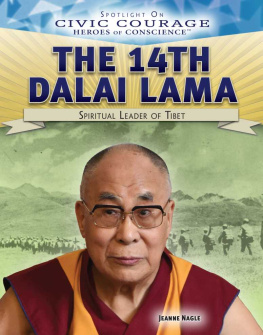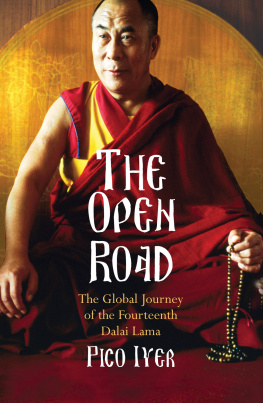ABOUT THE AUTHOR
After obtaining a degree in journalism, Annelie Rozeboom went to China for 12 months, and ended up staying 11 years. As the China correspondent for several national publications, she reported on the uprisings on Tiananmen Square, Chinas subsequent growth into an economic superpower, and the issue of Tibet. She now lives with her husband and their three children in Antananarivo, Madagascar, where she runs the only English-language newspaper in the country and teaches journalism and English at the American School of Antananarivo.
1.
IS THE OLD ALWAYS BETTER?
R edi, vice-chairman of the Standing Committee of the National Peoples Congress, puts on his annual meet-the-press-face: small, round and annoyed. Exasperated, he stares at the rows of Western journalists in the Great Hall of the People in Beijing. He looks them straight in the eyes. After the third question about human rights issues in Tibet and the Dalai Lama, he bursts out, All of you think that the old Tibet was so great. But we didnt have anything to eat. My brother died of starvation. Myself, I was bitten by dogs while I begged in the streets. I still have the scars. You call that a life?
This tirade is followed by the annual gush of insults against the Dalai Lama and his clique. The spiritual leader gets blamed for organizing just about every uprising since 1959. Whatever is wrong with Tibet, from economic hardship to political problems, it is all the Dalai Lamas fault. A journalist from the Times thinks that Redi is going too far. How can you accuse the peace-loving Dalai Lama of all this? Dont you think youre losing the propaganda war? he asks.
Redi becomes livid. Since 1959, when their armed uprising failed, the Dalai Lama and his followers havent given us a day of peace. They have constantly organized violent riots and even placed bombs. From the 1980s onwards, the Tibetan people could have lived quiet and prosperous lives. But the separatist activities never stopped. How can you call these people peaceful?
Redi is not only annoyed with the Dalai Lama. He also hates Western journalists who keep on defending the Dalai Lama and who portray him, Redi, as a traitor.
During these last years, the most ridiculous statements have been published in the Western press. You journalists live thousands of kilometers from my country, and you dont know anything about the old or the new Tibet. What do you want? To bring back the medieval reign of the Dalai Lama? You make up the most preposterous rumors. And you insult the Tibetan party leaders, but you dont know what youre talking about. You complain that there are new buildings in Tibet and that they dont look Tibetan. Well, new buildings look the same all over the world. Why do you think that the old is always better?
Redi has it wrong. Nobody is saying that the old is always better. Even the exiled Tibetans in India know that the old social system in Tibet needed to be reformed. How that old system worked is an important dispute between the two sides. The Chinese talk about cruel landowners, monks and aristocrats, who kept and mistreated their slaves. According to Chinese statistics, 90 percent of Tibetans were slaves in the old society. They worked for free on the lands of the rulers. In exchange for their labor, they got to work on their own plot of land. Those who couldnt pay their taxes became house slaves at their masters homes.
According to the China Daily, old Tibetan administration records of 1950, kept at the Archive of the Tibet Autonomous Region, show that 90 percent of Tibets one million people were homeless. Of the 20,000 inhabitants of Lhasa at the time, more than 1,000 families lived as beggars.
Before 1959, the China Daily writes, Tibet was a society of feudal serfdom under the despotic political-religious rule of lamas and nobles. The masses of serfs in Tibet did not even possess fundamental rights. Serf owners, principally local administrative officials, nobles, and upper-ranking lamas, owned all of Tibets farmlands, pastures, forests, mountains and rivers as well as most of the livestock. The serfs lived no better than the slaves in the plantations in the southern states of America. The serf owners could sell or transfer their serfs, present them as gifts, or use them as mortgage payments for debts. They could even exchange them, molest them or maltreat them. When two serfs got married, the husband and wife still belonged to different owners and their children were fated to be serfs from the moment they were born.
This system was set in stone, the media state. The statutory code of old Tibet stipulated that people were unequal in status by dividing people into three classes and nine ranks. In a peculiar law concerning the value of human life, it was written that the lives of people belonging to the highest rank of the upper class, such as a prince or leading Living Buddha, were calculated to be worth the weight of the dead body in gold, whilst the lives of people belonging to the lowest rank of the lower class, such as women, butchers, hunters and craftsmen, were worth a straw rope.
The judicial system of old Tibet gave monasteries and serf owners the right to judge, the media state, and punishment was cruel. Punishments issued by the courts were extremely savage and cruel and included gouging out the eyes, cutting off the ears, hands or feet; pulling out tendons; throwing the criminal into water or shutting the criminal in a wooden case lined with nails facing inwards. (All quotes from Chinatibetnews. com, March 21, 2008).
The Chinese media also give plenty of personal evidence. According to many original contracts preserved in the Archives of the Nationalities Cultural Palace and the Archive of the Tibet Autonomous Region, the manorial lords had the freedom to exchange serfs or present serfs to each other as gifts. Serfs had to pay high interest on their debts by doing corve (unpaid labor) or by selling their own children. A certificate, written in the old form of the Tibetan language used before 1959 and kept as File no. MC 1015 at the Archives of the Nationalities Cultural Palace, reads: Being unable to pay back the money and grain we owe Nedong Dekhang, we, Tsewang Rabten and my wife, serfs of the Dusong Manor, must give up our daughter Gensong Tonten and younger son Padma Tenzin to Dekhang to repay the debts. The descendants of their son and daughter will be Dekhangs serfs. (China Daily, April 10, 2008).
The Tibetan refugees in India have carried out their own studies of the old society in Tibet. In their publication Truth From Facts (one of Deng Xiaopings favorite sayings) they state that Tibets social system wasnt so bad, especially if you compare it to the situation in other Asian countries at that time. To start with, the most important leader, the Dalai Lama, was a reincarnation. That meant that he could be born into any kind of family, rich or poor. So leadership was not inherited, as it is in monarchies. Both the 13th and the 14th Dalai Lamas came from peasant families. Monks filled many of the lower government positions, and their nominations also had nothing do to with their backgrounds. Everybody, poor or rich, could enter a monastery and start a career.
The farmers serfs, according to the Chinese had legal status, the publication says. They possessed documents in which their rights were precisely stated. They could also go to court if they had a problem. There was no problem at all for a farmer to sue his master. The 13th Dalai Lama passed a law in 1909 that stipulated that all serfs who had a problem could come and complain directly to him. But, according to the Tibetans, such disputes didnt happen often, as the people treated each other decently due to their Buddhist principles. It was a religious duty for the rich to take care of the poor. Capital punishment didnt exist in the old Tibet and only the Supreme Court could hand out harsh punishments like dismembering hands. In 1898, Tibet enacted a law abolishing such forms of punishment, except in cases of high treason or conspiracy against the state.





